Discover the captivating world of abstract painting and its most famous works with me. Through an examination of key techniques and styles, I’ll guide you into the complexities of abstract art and what makes these iconic works so timeless and enduring.
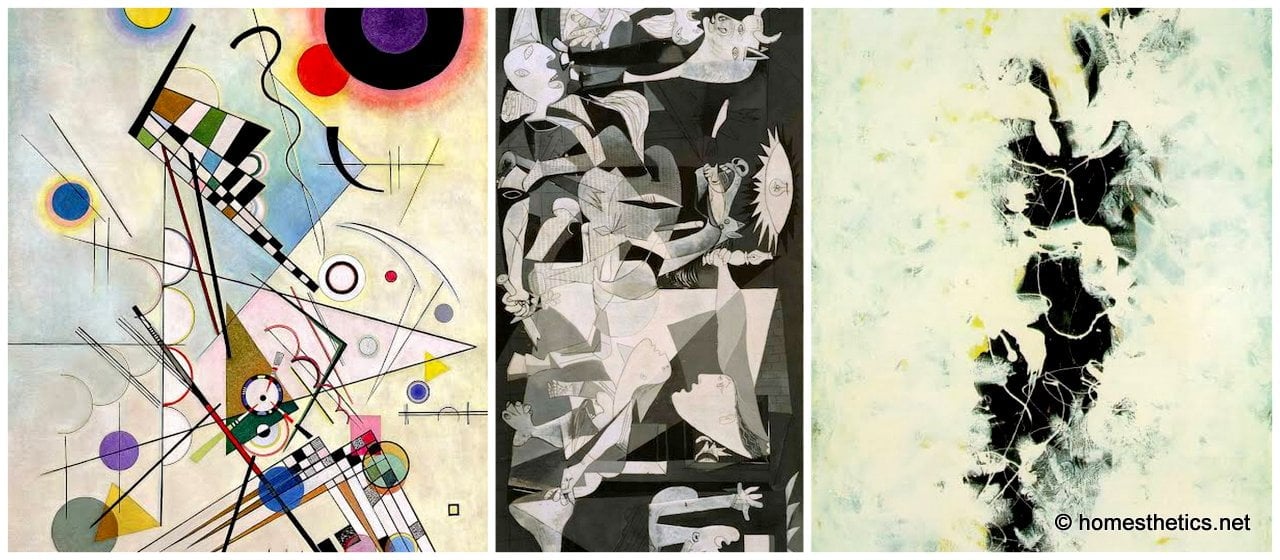
Ladies and gentlemen, if you ever thought abstract paintings were just a bunch of meaningless splatters and shapes, then you're in for a surprise!
As you stand before a magnificent abstract painting, you are transported to a world beyond what the eye can see. The colors and lines dance before you, telling a story of emotion and expression that is both mysterious and captivating. So, join me on this journey through the world of famous abstract paintings.
Famous Abstract Paintings
1. No. 61 (Rust and Blue) by Mark Rothko
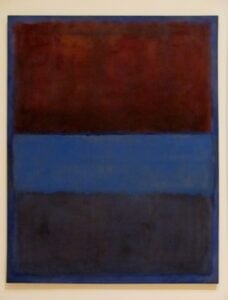
This painting is all about emotion and mood. The first thing you'll notice is its massive size, measuring over 9 feet wide and 7 feet tall. It's hard not to be drawn in by the sheer scale of it. No. 61 has a passionate hue, similar to the city of love, Paris.
Once you get closer, you'll notice the two dominant colors - rust and blue - which are layered on top of each other in a color field that seems almost hazy and dreamlike. There's a sense of depth and texture that draws you in, and the longer you look at it, the more you'll start to feel like you're being enveloped by the painting.
Mark Rothko was a master of color, and he uses it here to create a sense of tranquility and calmness. It's almost like you're looking at a beautiful sunset, but instead of seeing a literal depiction of the scene, you're experiencing the feeling of it.
The painting is also part of the collection of the Museum of Modern Art (MoMA) in New York City, further cementing its connection to the United States art world.
The painting is deceptively simple, but it's filled with so much emotion and depth that it's impossible to look away. It's a beautiful example of how art can communicate something beyond words or images, and it's definitely worth seeing in person if you ever get the chance.
2. Abstraction White Rose by Georgia O'Keeffe

At first glance, this oil painting may seem simple and minimalistic, but there's so much more going on beneath the surface. The painting is dominated by a large white rose, which is rendered in a way that's both abstract and highly detailed. The petals are layered on top of each other, creating a sense of depth and dimensionality that draws you in.
But what's most interesting about the aesthetics is the way that O'Keeffe uses negative space to create a sense of balance and harmony. The rose is surrounded by a sea of white, which could easily overpower the delicate flower. But instead, the white space feels like an extension of the rose, as if the two are working in perfect harmony together.
There's also a sense of mystery and intrigue in this painting. The white rose is both a recognizable symbol of beauty and innocence but also an abstract form that's open to interpretation. It's like O'Keeffe is inviting us to look closer and explore the hidden depths of the painting.
Overall, "Abstraction White Rose" is a stunning example of O'Keeffe's mastery of form, balance, and composition. It's a painting that rewards careful attention and invites us to explore the beauty of the natural world through an abstract lens.
3. Elegy to the Spanish Republic No. 110 by Robert Motherwell
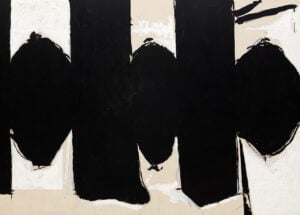
This painting is a tribute to the Spanish Republic, which was overthrown by fascist forces during the Spanish Civil War. Motherwell was deeply affected by the conflict, and this painting is a powerful expression of his grief and anger.
The painting is dominated by a large black shape that seems to loom over the canvas like a dark cloud. It's a symbol of the oppressive forces that Motherwell saw at work in the world, and it creates a sense of foreboding and tension.
But there's also a sense of hope and resilience in the painting. The black shape is balanced by a series of white lines and shapes that seem to push back against it. It's like Motherwell is saying that even in the darkest of times, there is always a glimmer of light and hope.
Overall, "Elegy to the Spanish Republic No. 110" is a stunning example of how abstract art can be used to communicate complex emotions and political ideas. It's a concept that invites us to contemplate the darker aspects of human nature but also to celebrate our capacity for resilience and hope.
4. Woman I by Willem de Kooning
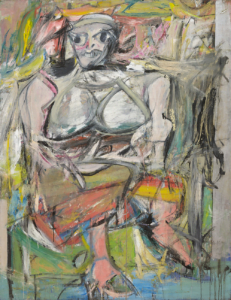
This painting is a tour de force of color, form, and emotion. It depicts a woman in an abstract and distorted form, with bright pinks, blues, and yellows dominating the canvas. The painting is both beautiful and unsettling, with a sense of raw energy and passion that's hard to ignore.
What's most interesting about this painting is the way that de Kooning uses abstraction to challenge traditional notions of beauty and femininity. The woman in the painting is depicted in a nude and highly sexualized way, with exaggerated curves and suggestive shapes. But at the same time, she's rendered in a way that's almost grotesque and distorted, as if de Kooning is critiquing society's objectification of women.
The painting has been the subject of much controversy and debate over the years. Some have criticized it for its portrayal of women, while others have praised it for its boldness and innovation.
But regardless, there's no denying its power and impact. It's a painting that demands attention and provokes strong emotions, whether you love it or hate it. This is a painting that challenges our preconceptions and invites us to see the world in a new and different way.
5. In Memory of My Feelings by Jasper Johns

Oh, "In Memory of My Feelings" by Jasper Johns is definitely worth talking about! It's a series of abstract prints that was created in collaboration with the poet Frank O'Hara in the 1960s.
What's interesting about this piece is that it's not just a simple visual representation of the poem. Instead, the prints and the poems play off of each other to create a layered and complex emotional experience. Pop art often features bright, bold colors like the vivid hues in this painting.
Each print features different layers of images and text, with some elements repeated across multiple prints. It's almost like a puzzle that the viewer has to put together to understand the meaning behind the work fully.
Overall, it is a beautiful and thought-provoking work that rewards careful examination and contemplation.
6. Morning Mist, Maine by Georgia O'Keeffe
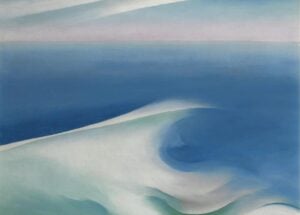
It is a stunning painting that captures the ethereal beauty of a misty morning in Maine. The soft, muted blues and greens of the mist contrast with the bright, warm orange of the sun rising in the background. This creates a dynamic interplay between the foreground and background and draws the viewer's eye across the painting.
The misty landscape is rendered in simple, abstract forms that suggest trees, rocks, and water but are not overly detailed. This allows the viewer to fill in the gaps with their own imagination and creates a sense of mystery and intrigue.
Another interesting aspect of this painting is the way that it plays with scale. The foreground rocks are rendered in large, almost abstract shapes that dwarf the tiny figures in the distance. This creates a sense of grandeur and awe and emphasizes the power and majesty of nature.
7. Simultaneous Contrasts: Sun and Moon by Robert Delaunay
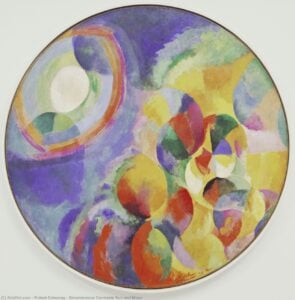
This is a painting that will make you want to stare at it for hours. The painting, completed in 1913, features a dynamic circular composition with bold contrasting colors of yellow, blue, and red. The painting is divided into two sections, one representing the sun and the other the moon, with both elements depicted in an abstract and stylized manner.
What's fascinating about this painting is Delaunay has captured the essence of light and color. The circles of color seem to vibrate and pulsate, giving the impression of the sun and moon in motion. It's almost as if the painting is alive, with the colors and shapes interacting with one another in a symphony of light and movement.
Delaunay was a master of the art movement known as Orphism, which sought to create abstract art that evoked a sense of rhythm and musicality. "Simultaneous Contrasts: Sun and Moon" is a perfect example of this, as it captures the rhythm of the celestial bodies and the harmony of color in a way that is both stunning and mesmerizing.
Overall, "Simultaneous Contrasts: Sun and Moon" is a work of art that will capture your imagination and leave you breathless with its beauty and complexity. It's a painting that demands your attention and rewards you with a visual experience that is truly unforgettable.
8. Composition VIII by Wassily Kandinsky
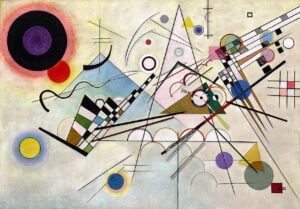
This painting is an absolute masterpiece that will transport you to another world with its bold colors and intricate composition. Completed in 1923, "Composition VIII" is a riot of color and form. The overall effect is one of movement and dynamism as if the painting is a living thing that is constantly shifting and changing.
One of the most striking things about this painting is Kandinsky's use of color. The bright blues, yellows, and reds seem to jump off the canvas, while the darker colors add depth and complexity. The colors are not just random but carefully chosen to create a sense of balance and harmony within the painting.
The composition itself is also incredibly complex, with different shapes and lines intersecting and overlapping in a way that is both beautiful and intriguing. Kandinsky was a master of abstraction, and in "Composition VIII," he created a painting that symbolizes the vastness of the universe, something that is both abstract and yet somehow grounded in reality.
Overall, "Composition VIII" is a painting that will leave you awestruck with its beauty and complexity. It's a painting that rewards close inspection, as there are always new details and nuances to discover. If you're a fan of abstract art or just art in general, this is a painting that you simply must see in person to fully appreciate.
9. The Deep by Jackson Pollock

"The Deep" by Jackson Pollock is a painting that is both chaotic and mesmerizing at the same time. Completed in 1953, it is a classic example of Pollock's drip painting technique, where he would drip or pour paint onto the canvas in a seemingly random manner.
At first glance, "The Deep" may seem like a mess of swirling lines and splatters of paint. But upon closer inspection, you can see the careful control and intention behind each mark.
The raw, earthy hues and textures of The Deep are reminiscent of the natural world and the sculpture it creates. The colors used in "The Deep" are deep, and the painting seems to evoke a sense of depth and movement as if you're peering into some kind of mystical abyss.
One of the most interesting things about this painting is the way in which it was created. Pollock famously worked on the floor, using his whole body to create the painting. The drips and splatters of paint were created through a kind of dance between the artist and the canvas, with each movement carefully choreographed to create a specific effect.
10. Helen Frankenthaler’s Mountains and Sea
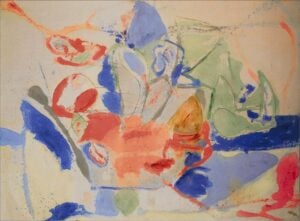
Let me tell you about one of the most famous abstract paintings in the art world, Helen Frankenthaler's "Mountains and Sea." This abstract watercolor painting was created in 1952 during the post-war era, a time when abstract art was taking the art world by storm. Frankenthaler was part of the Abstract Expressionist movement, a group of artists who used abstraction to convey their emotions and feelings.
"Mountains and Sea" is a prime example of the soak-stain technique that Frankenthaler is known for. This technique involved diluting the paint with turpentine and then soaking it into the unprimed canvas. The resulting effect is a beautiful blend of colors that flow together like water, making the painting look like an abstract landscape.
The painting is dominated by shades of blue and green, which are blended seamlessly with each other to create a sense of movement and depth. Frankenthaler's signature style is apparent in the loose watercolor brushstrokes and the way the colors blend together, creating a dreamy atmosphere that transports the viewer into a world of abstract motifs.
11. Composition with Red, Blue, and Yellow (1930) by Piet Mondrian
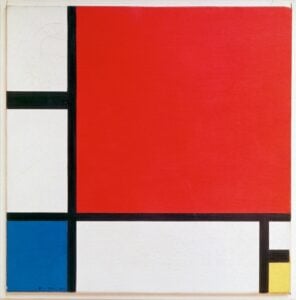
Composition with Red, Blue, and Yellow is one of the most famous abstract paintings in the world. Created in 1930 by Netherlands' Dutch artist Piet Mondrian, the painting exemplifies the style of De Stijl, a modern art movement that emphasized geometric forms and primary colors.
What makes this painting so unique is its bold and minimalist approach to composition. Mondrian reduces the elements of his painting to their simplest forms, using only rectangular shapes and primary colors to create a striking geometric pattern. The colors themselves are vivid and intense, with the bright red, blue, and yellow tones contrasting sharply against each other.
In contrast to the minimalist approach of Mondrian's "Composition with Red, Blue, and Yellow," "Broadway Boogie Woogie" (1942-43) features a dynamic and intricate composition of colored squares that evoke the bustling energy of New York City's streets.
All in all, "Composition with Red, Blue, and Yellow" is a classic example of philosophy in abstract art that continues to captivate audiences today. Its influence can be seen in the work of many contemporary artists who continue to experiment with the principles of pure abstraction, geometric shapes, and vivid colors in their own art.
12. Gray Mirrors by Gerhard Richter

Gray Mirrors is an extraordinary piece of abstract art created by the famous German artist Gerhard Richter. This artwork is a masterpiece that reflects the essence of minimalism and the versatility of the abstract art genre. Richter's Gray Mirrors is one of the most famous abstract paintings of all time and for a good reason.
It's a beautiful example of the abstract movement and showcases the incredible talent of one of the most prominent abstract artists in history. The artwork features a series of geometric shapes and lines arranged in a way that creates a mesmerizing visual effect. The painting's color scheme is primarily gray, with hints of blue and green, which adds to its overall calming and serene vibe.
Gray Mirrors is part of a larger series of over 100 abstract artworks that showcase Richter's talent and versatility as an abstract painter. His works have been featured in some of the world's most prominent art galleries, and he's known for producing art that reflects both figurative art and abstract art styles. Richter's influence on the art world is profound, and his paintings are some of the most expensive abstract paintings in the world.
13. The Swan by Hilma af Klint
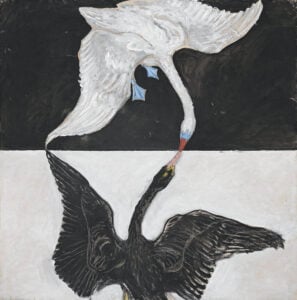
Hilma af Klint's "The Swan" is an otherworldly masterpiece that stands out even among the most famous abstract paintings of the past century. While the painting shares some elements with surrealism, it is truly in a category of its own.
Af Klint was ahead of her time, creating abstract paintings long before the abstract expressionism movement of the mid-twentieth century. "The Swan" was painted in 1915, making it one of the earliest examples of abstract art in Sweden.
Despite this, her works remained unknown for more than a century, and it wasn't until the 1980s that they were first exhibited. Today, her paintings are celebrated for their otherworldly beauty and intricate geometric patterns.
14. Ad Parnassum by Paul Klee
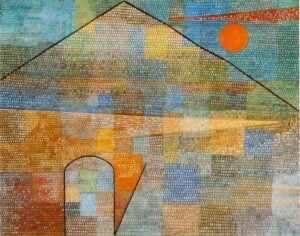
Have you heard of Paul Klee's famous abstract painting "Ad Parnassum"? It's a great example of the modernist movement in art that emerged in the early 20th century in Switzerland.
"Ad Parnassum" is an abstract painting that showcases Klee's fascination with geometric shapes and patterns. The composition of the painting is complex and layered, with different shapes and lines intersecting to create a harmonious whole. The painting is dominated by cool blues and grays, with occasional splashes of warmer colors like yellow and orange.
If you ever get the chance to see "Ad Parnassum" in person, it's definitely worth the trip. The painting is currently on display at the Albright-Knox Art Gallery, New York City, where it's considered one of the gallery's most famous paintings. Its light & dark phases, pure art, and abstract works make it stand out. You'll be amazed by the intricate details and the way the colors and shapes come together to create something truly unique.
15. The Persistence of Memory (1931) by Salvador Dali
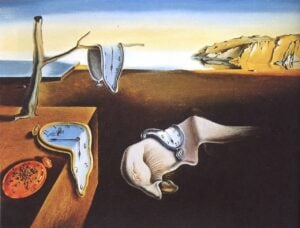
If you're looking for a mind-bending example of famous abstract paintings, look no further. The Persistence of Memory" features a dreamlike landscape of melting watches and distorted forms, set against a backdrop of the rocky landscape of La Mancha, Spain.
The painting is a prime example of Dali's unique style, which blended the traditional art of Europe with avant-garde surrealism in Russia. It has been reproduced countless times and has inspired countless artists and writers over the years.
One of the fascinating things about this painting is its ability to evoke a sense of both timelessness and decay. The melting watches seem to suggest the passing of time, while the barren, rocky landscape and distorted forms hint at a world in a state of decay.
16. Composition in Black and White (1913) by Kazimir Malevich
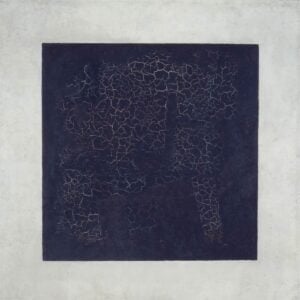
This piece was created in 1913, just a few years before the Russian Revolution that led to the collapse of the Russian empire. This iconic work of art is one of the most famous examples of Suprematism, a movement that focused on geometric shapes and the use of simple forms to express complex ideas.
At the heart of this painting is the infamous black square, which Malevich believed represented the "zero degrees" of painting. He saw it as the starting point for all art, a way to break free from the constraints of representational art and explore the power of pure abstraction.
Despite its minimalist appearance, Composition in Black and White is a striking work of art that draws you in with its stark contrast of black and white shapes. Malevich's use of bold lines and shapes creates a dynamic and visually captivating composition that challenges our perceptions of space and form.
17. The Tilled Field by Joan Miró
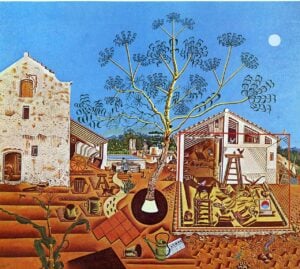
"The Tilled Field" by Joan Miró is a visually striking and complex abstract painting that rewards close inspection. The painting features a vibrant array of geometric shapes, lines, and patterns arranged in a seemingly haphazard yet balanced composition.
The painting is dominated by a series of oval and circular shapes in various shades of blue and green, which contrast sharply with the warm earth tones in the lower right corner. Despite the abstract nature of the painting, there are also figurative elements present. In the background, a landscape scene can be discerned, with fields and hills in the distance.
One of the most striking features of "The Tilled Field" is the use of negative space. The large areas of blank canvas around and between the shapes serve to create a sense of movement and tension. The overall effect is one of energy and vitality, with the composition appearing to be in a state of constant flux.
"The Tilled Field" is a testament to Joan Miró's skill as an abstract artist, as well as his ability to combine figurative and abstract elements in a harmonious and thought-provoking way. It remains a favorite among art lovers and a fascinating example of the possibilities of abstract art.
18. Guernica by Pablo Picasso

Guernica by Pablo Picasso is one of the most famous abstract paintings in modern art history. The painting was created in 1937 and is a reaction to the bombing of the Spanish town of Guernica during the Spanish Civil War. It is a striking and powerful work of art that showcases the horrors of war in a unique and innovative way.
Picasso, who was a pioneer of the Cubism movement, used this style to create the artwork. The painting features an array of abstract shapes and lines that come together to form a large, chaotic image. The monochrome color palette of black, white, and grey further adds to the unsettling mood of the painting.
Picasso was already a famous abstract artist when he created Guernica, but this painting solidified his place as one of the most influential and celebrated artists of all time. It is a prime example of how an artist can use their skills to create powerful and influential works of art that stand the test of time.
19. White Relief by Ben Nicholson

White Relief, created by British artist Ben Nicholson, is a beautiful example of abstract art that captures the essence of minimalism and simplicity. The painting consists of a white square relief made up of intersecting lines that form smaller squares and rectangles.
What makes this piece so interesting is its ability to convey so much with so little. The use of minimal color and simple geometric shapes makes the painting incredibly versatile and adaptable to different spaces and moods. The white color scheme creates a sense of purity and tranquility, while the interlocking lines and shapes evoke a feeling of movement and energy.
One fascinating aspect of the artwork is how it plays with light and shadow. Depending on the angle and source of light, the relief can create different patterns and textures, adding an extra layer of intrigue and complexity to the piece.
Overall, White Relief is a stunning example of abstract art that showcases the beauty of minimalism and simplicity. Its timeless design and versatility have earned it a place among the most famous abstract artworks in history.
20. Painting Number 2 by Franz Kline
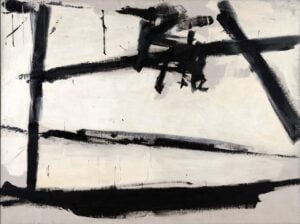
Painting Number 2 was painted in 1954, and it's an excellent example of Kline's signature style. Kline was one of the most famous abstract artists of the 20th century, and his work has had a significant impact on the art world. He was one of the pioneers of abstract painting, and his artwork is still revered today.
His work is characterized by bold brushstrokes and a sense of movement, and Painting Number 2 is no exception. The painting is done in black and white, and it's an abstract expressionist piece.
While watercolor is known for its transparency and delicate washes, artists can achieve a bold, graphic look with acrylics, as seen in Franz Kline's "Painting Number 2." The black-and-white palette and gestural brushstrokes create a dynamic composition that draws the viewer's eye.
The composition of the painting is striking, with thick black lines dominating the canvas and smaller white marks adding contrast and depth. The black lines appear to move and twist, creating a sense of tension and drama that draws the viewer in.
21. I Saw the Figure 5 in Gold by Charles Demuth
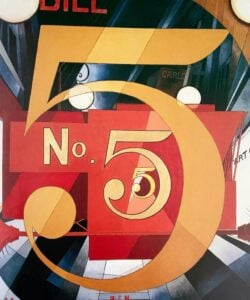
"I Saw the Figure 5 in Gold" by Charles Demuth is a famous abstract painting that blends elements of realism and futurism in a truly unique way. Created in 1928, the painting is a tribute to the poet William Carlos Williams, who wrote a poem titled "The Great Figure" about a fire engine racing through the streets of New York City.
The painting features a bold, gold numeral 5 surrounded by various shapes and lines that seem to suggest movement and speed. The geometric shapes give the painting a futuristic feel, while the gold color adds a sense of luxury and elegance. At the same time, the painting also has a certain level of realism, with recognizable elements like the lettering on the side of the fire engine.
What makes "I Saw the Figure 5 in Gold" so interesting is the way in which it plays with the boundaries between different art genres. On one hand, the painting is clearly abstract, with its emphasis on shapes and colors over realistic representation. On the other hand, it also has elements of realism, with recognizable objects like the fire engine and the lettering.
Abstract artists create their works of art through a variety of techniques, including gestural brushstrokes, drips, splatters, and the use of color and texture to convey emotions or ideas. The light & dark phase in abstract art refers to the use of contrast between light and dark colors to create a dynamic and impactful composition. This technique is often used in modern abstract painting to create depth and dimension within the artwork. Some characteristics of modern abstract painting include the use of bold colors, gestural brushstrokes, and the incorporation of texture and pattern within the artwork. These elements often work together to create a sense of movement and energy within the piece. The abstract movement has influenced other art forms, such as abstract reliefs and post-painterly abstraction, through its emphasis on experimentation with form and color. Many artists have been inspired by the techniques and ideas of the abstract art period and have adapted them to their own artistic styles. Lyrical abstraction is a form of abstract art that emphasizes the use of organic shapes and gestural brushstrokes to create a sense of movement and rhythm within the composition. It differs from geometric abstraction, which emphasizes the use of precise geometric shapes and lines. World events such as World War II had a significant impact on the development of abstract art. Many artists sought to create artworks that were free from the constraints of traditional representation and explored new forms of expression through abstraction. The study of art history is significant when studying abstract art because it helps to provide context for the development of the abstract art movement and the artists who were involved. Understanding the historical and cultural context of abstract art can help to deepen our appreciation and understanding of the artwork. Contemporary art often incorporates abstract elements such as gestural brushstrokes and bold colors into its compositions. This incorporation of abstract elements can help to convey emotions or ideas in a powerful and dynamic way, and it reflects the continued influence of the abstract art genre on modern art.Abstract Paintings FAQs
Final Thoughts
As we stand in awe of these masterpieces, we can't help but feel a connection to the artists who created them. The pinnacle of this art form can be seen in the interchanges of color, resulting in a breathtaking display of knowledge and emotion that speaks to our very souls.
It's like a child's imagination brought to life on a wall with the use of pigment and palette. From the studio to the auction house, these paintings have become a part of our culture. They're more than just drawings on canvas - they're a language that speaks to us in a way that words cannot. They remind us of our humanity and our desire to create and connect with one another.
So let's raise a glass to the fathers of abstract painting, who have given us nothing less than masterpieces of science and art. Let's celebrate the Broadway Theatre of our minds, where these paintings come to life and speak to us in a language that transcends borders and boundaries. Let's bask in the lavender glow of their beauty and the fathomless depth of their meaning.
